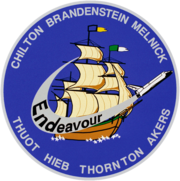STS-49
| STS-49 | |||||
 | |||||
| Uppdrag | 47 | ||||
|---|---|---|---|---|---|
| Rymdfärja | Endeavour (1)[1] | ||||
| NSSDC-ID | 1992-026A[2] | ||||
| Färdens tid | 8 dagar, 21 timmar, 17 minuter, 38 sekunder | ||||
| Uppskjutning | |||||
| Startplats | Startplatta 39B vid Kennedy Space Center i Florida | ||||
| Start | 7 maj 1992, 7:40 p.m. EDT | ||||
| Landning | |||||
| Landningsplats | Runway 22, EAFB | ||||
| Landning | 16 maj 1992, 6:57:38 p.m. EDT | ||||
| Omloppsbana | |||||
| Varv | 140 st[3] | ||||
| Apogeum | 341 km | ||||
| Perigeum | 268 km | ||||
| Banlutning | 28,35° | ||||
| Sträcka | 5,948 miljoner km | ||||
| Rymdpromenad | |||||
| Antal | 4 st | ||||
| Total tid | 25 timmar, 26 minuter | ||||
| Besättning | |||||
| Befälhavare | Daniel C. Brandenstein (4) | ||||
| Pilot | Kevin P. Chilton (1) | ||||
| Uppdragsspecialister | Pierre J. Thuot (2) Kathryn C. Thornton (2) Richard J. Hieb (2) Thomas D. Akers (2) Bruce E. Melnick (2) | ||||
 | |||||
| Kronologi Rymdfärjeprogrammet | |||||
| |||||
STS-49 var den fyrtiosjunde flygningen i det amerikanska rymdfärjeprogrammet, den första flygningen med rymdfärjan Endeavour. Rymdfärjan sköts upp från Kennedy Space Center den 7 maj 1992. Efter nästan nio dagar i omloppsbana runt jorden återinträdde rymdfärjan i jordens atmosfär och landade vid Edwards Air Force Base i Kalifornien.
Flygningens mål var att rädda satelliten Intelsat 603, som skjutits upp med en Commercial Titan III-raket den 14 mars 1990.
Under flygningen genomfördes världens hittills enda rymdpromenad som involverade tre personer.
Rymdpromenader
| Nr | Rymdpromenerare | Start (UTC) | Slut (UTC) | Varaktighet |
|---|---|---|---|---|
| 1. | Pierre J. Thuot Richard J. Hieb | 10 maj 1992 20:40 | 11 maj 1992 00:23 | 3 timmar, 43 minuter |
| 2. | Pierre J. Thuot Richard J. Hieb | 11 maj 1992 21:05 | 12 maj 1992 02:35 | 5 timmar, 30 minuter |
| 3. | Pierre J. Thuot Richard J. Hieb Thomas D. Akers | 13 maj 1992 21:17 | 14 maj 1992 05:46 | 8 timmar, 29 minuter |
| 4. | Thomas D. Akers Kathryn C. Thornton | 14 maj 1992 ~21:00 | 15 maj 1992 ~04:45 | 7 timmar, 44 minuter |
Se även
Referenser
- ^ NASA Space Shuttle Launch Archive Arkiverad 17 februari 2013 hämtat från the Wayback Machine., läst 28 juli 2016.
- ^ ”NASA Space Science Data Coordinated Archive” (på engelska). NASA. https://nssdc.gsfc.nasa.gov/nmc/spacecraft/display.action?id=1992-026A. Läst 19 mars 2020.
- ^ Manned Astronautics - Figures & Facts Arkiverad 1 april 2016 hämtat från the Wayback Machine., läst 28 juli 2016.
Externa länkar
 Wikimedia Commons har media som rör STS-49.
Wikimedia Commons har media som rör STS-49.
| ||||||||
| ||||||||||||||||||||||||||||||||
Media som används på denna webbplats
Författare/Upphovsman: Pascal (Flickr user: pasukaru76), Licens: CC0
Vostok spacecraft replica at the Technik Museum Speyer, Germany.
STS-49 Patch
- STS-49 Endeavour, Orbiter Vehicle (OV) 105, crew insignia (logo), the official insignia of the NASA STS-49 mission, captures space flight's spirit of exploration which has its origins in the early seagoing vessels that explored the uncharted reaches of Earth and its oceans. The ship depicted on the patch is HMS Endeavour, the sailing vessel which Captain James Cook commanded on his first scientific expedition to the South Pacific. Just as Captain Cook engaged in unprecedented feats of exploration during his voyage, on Endeavour's maiden flight, its crew will expand the horizons of space operations with an unprecedented rendezvous and series of three space walks. During three consecutive days of extravehicular activity (EVA), the crew will conduct one space walk to retrieve, repair and deploy the INTELSAT IV-F3 communications satellite, and two additional EVAs to evaluate the potential Space Station Freedom (SSF) assembly concepts. The flags flying on Endeavour's masts wear the colors of the two schools that won the nationwide contest when Endeavour was chosen as the name of NASA's newest Space Shuttle: Senatobia (Mississippi) Middle School and Tallulah Falls (Georgia) School The names of the STS-49 flight crewmembers are located around the edge of the patch. They are Commander Daniel C. Brandenstein, Pilot Kevin P. Chilton, Mission Specialist (MS) Pierre J. Thuot, MS Kathryn C. Thornton, MS Richard J. Hieb, MS Thomas D. Akers, and MS Bruce E. Melnick. Each crewmember contributed to the design of the insignia.
STS-45 Mission Insignia
The crew patch of STS-50, United States Microgravity Laboratory-One (USML-1), captures a Space Shuttle traveling above Earth while trailing the USML banner. The Orbiter is oriented vertically in a typical attitude for microgravity science and in this position represents the numeral 1 in the mission's abbreviated title. This will be the first in a series of USML flights where the primary objective is microgravity science, planned and executed through the combined efforts of our country's government, industry, and academia.
Visible in the orbiter's payload bay are the Spacelab module, and the extended duration Orbiter "cryo" pallet which is being flown for the first time on STS-50. The small g and Greek letter mu on the Spacelab module symbolize the microgravity environment being used for research in the areas of materials science and fluid physics. The large block letter U extends outside of the patch's perimeter, symbolizing the potential for the experiments on this flight to expand the current boundaries of knowledge in microgravity science.
The Stars and Stripes of the USML block letter and the U.S. landmass visible in the Earth scene below the Orbiter reflect the crew's pride in the United States origin of all on-board experiments.The STS-49 crew members pose near Endeavour after landing. Pictured left to right are: Richard J. Hieb, mission specialist; Kevin P. Chiltin, pilot; Daniel C. Brandenstein, commander; and mission specialists Thomas D. Akers, Pierre J. Thuot, Kathryn C. Thornton, and Bruce E. Melnick.







